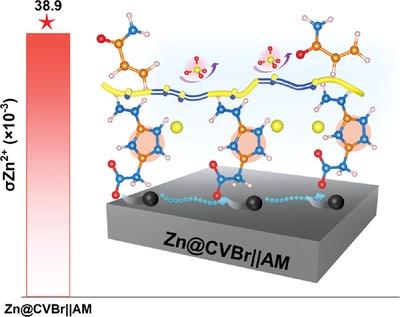当前位置:
X-MOL 学术
›
Adv. Funct. Mater.
›
论文详情
Our official English website, www.x-mol.net, welcomes your feedback! (Note: you will need to create a separate account there.)
Tailoring Anion Association Strength Through Polycation-Anion Coordination Mechanism in Imidazole Polymeric Ionic Liquid-Based Artificial Interphase toward Durable Zn Metal Anodes
Advanced Functional Materials ( IF 19.0 ) Pub Date : 2023-03-16 , DOI: 10.1002/adfm.202301129 Jiaqi Ke 1 , Zhipeng Wen 1 , Yang Yang 2 , Rong Tang 2 , Yongchao Tang 1 , Minghui Ye 1 , Xiaoqing Liu 1 , Yufei Zhang 1 , Cheng Chao Li 1, 3
Advanced Functional Materials ( IF 19.0 ) Pub Date : 2023-03-16 , DOI: 10.1002/adfm.202301129 Jiaqi Ke 1 , Zhipeng Wen 1 , Yang Yang 2 , Rong Tang 2 , Yongchao Tang 1 , Minghui Ye 1 , Xiaoqing Liu 1 , Yufei Zhang 1 , Cheng Chao Li 1, 3
Affiliation

|
Artificial interface layer engineering is an efficacious modification strategy for protecting zinc anode from dendrite growth and byproducts formation. However, the high bulk ionic conductivity of most artificial interfacial layers is mainly contributed by the movement of anions (SO42−), which is the source of parasitic reactions on zinc anode. Herein, a high zinc ion donor transition (σZn2+ = 3.89 × 10−2 S cm−1) imidazole polymeric ionic liquid interface layer (1-carboxymethyl-3-vinylimidazolium bromide monomer, CVBr) for Zn metal protection is designed. The N+ atom of imidazole rings is connected by chains to form the cavities and the anions are confined within these cavities. Thus, the hindering effect of surrounding units on the anions leads to the subdiffusive regime, which inhibits the diffusion of SO42− in interface and increases Zn2+ transference number. Besides, the polycation-anion coordination mechanism of PolyCVBr ensures accelerated Zn2+ transition and realizes rapid internal Zn2+ migration channel. As a result, the Zn@CVBr||AM symmetry cells deliver high bulk ionic conductivity (4.42 × 10−2 S cm−1) and high Zn2+ transference number (tZn2+ = 0.88) simultaneously. The Zn@CVBr||AM-NaV3O8 pouch cells display the capacity retention of 88.9% after 190 cycles under 90° bending, verifying their potential practical application.
中文翻译:

通过咪唑聚合离子液体基人工界面中的聚阳离子-阴离子配位机制调节阴离子缔合强度以获得耐用的锌金属阳极
人工界面层工程是保护锌阳极免受枝晶生长和副产物形成的有效改性策略。然而,大多数人工界面层的高体积离子电导率主要是由阴离子 (SO 4 2− )的移动贡献的,这是锌阳极上寄生反应的来源。在此,设计了一种用于锌金属保护的高锌离子供体跃迁(σZn 2+ = 3.89 × 10 -2 S cm -1)咪唑聚合离子液体界面层(1-羧甲基-3-乙烯基咪唑溴化物单体,CVBr)。N +咪唑环的原子通过链连接形成空腔,阴离子被限制在这些空腔内。因此,周围单元对阴离子的阻碍作用导致了次扩散状态,这抑制了SO 4 2−在界面中的扩散并增加了Zn 2+迁移数。此外,PolyCVBr的聚阳离子-阴离子配位机制保证了Zn 2+加速跃迁,实现了Zn 2+内部快速迁移通道。因此,Zn@CVBr||AM 对称电池具有高体积离子电导率(4.42 × 10 -2 S cm -1)和高 Zn 2+转移数(tZn 2+ = 0.88)同时。Zn@CVBr||AM-NaV 3 O 8软包电池在90°弯曲下循环190次后容量保持率为88.9%,验证了其潜在的实际应用。
更新日期:2023-03-16
中文翻译:

通过咪唑聚合离子液体基人工界面中的聚阳离子-阴离子配位机制调节阴离子缔合强度以获得耐用的锌金属阳极
人工界面层工程是保护锌阳极免受枝晶生长和副产物形成的有效改性策略。然而,大多数人工界面层的高体积离子电导率主要是由阴离子 (SO 4 2− )的移动贡献的,这是锌阳极上寄生反应的来源。在此,设计了一种用于锌金属保护的高锌离子供体跃迁(σZn 2+ = 3.89 × 10 -2 S cm -1)咪唑聚合离子液体界面层(1-羧甲基-3-乙烯基咪唑溴化物单体,CVBr)。N +咪唑环的原子通过链连接形成空腔,阴离子被限制在这些空腔内。因此,周围单元对阴离子的阻碍作用导致了次扩散状态,这抑制了SO 4 2−在界面中的扩散并增加了Zn 2+迁移数。此外,PolyCVBr的聚阳离子-阴离子配位机制保证了Zn 2+加速跃迁,实现了Zn 2+内部快速迁移通道。因此,Zn@CVBr||AM 对称电池具有高体积离子电导率(4.42 × 10 -2 S cm -1)和高 Zn 2+转移数(tZn 2+ = 0.88)同时。Zn@CVBr||AM-NaV 3 O 8软包电池在90°弯曲下循环190次后容量保持率为88.9%,验证了其潜在的实际应用。


























 京公网安备 11010802027423号
京公网安备 11010802027423号